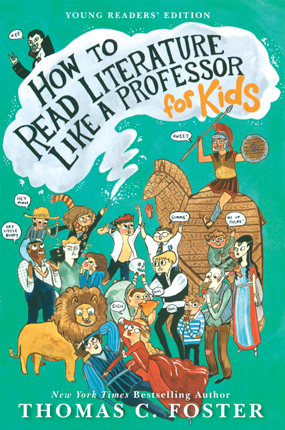Full Text Reviews: School Library Journal - 03/01/2013 Gr 6–9—This companion to the author's adult titles is geared toward young people who want to get a bit more out of J.K Rowling or Dr. Seuss. Foster uses both of these authors, along with Shakespeare and Homer (not Simpson), to illustrate various approaches to literature. He argues that there is really only one story, that of a journey or quest, and that it takes shape in many forms, in novels, plays, and poems. The book also delves into symbolism, irony, and the political and geographical aspects of literature. Readers will enjoy seeing Green Eggs and Ham from Foster's perspective of how food is often more than just a meal. Of course, he also touches on how the Bible, folk and fairy tales, and ancient literature form the basis of many of our favorite stories. His passion for literature is evident, and the text is readable and encouraging. While it would be a rare reader who would be familiar with every title the author cites, the arguments that he poses are solid and the examples are always apt. Students won't find literary research here, but they will find some valuable guidance on how to read critically and hopefully be inspired to read more widely.—Carol Fazioli, Barth Elementary School, Pottstown, PA - Copyright 2013 Publishers Weekly, Library Journal and/or School Library Journal used with permission. Booklist - 04/15/2013 Opening with a quickly and effectively illuminated scene from Lorraine Hansberry’s A Raisin in the Sun and continuing through such high-school syllabus texts as The Odyssey, Shakespeare’s works, a sonnet by Christina Rossetti, and more, this introduction to literary methods, tropes, and symbols is refreshingly accessible. Without condescension, Foster adapts some of the concepts that he presents in his adult titles, including How to Read Literature like a Professor (2003), with kid-friendly examples, such as Dr. Seuss stories that show how a universal literary theme can play out in a specific work without losing its universal meaning. With a closing short story that invites young readers to try out their newfound analytical skills, this slim guidebook can provide language art students with just the right open window to catch the academic breeze of enlightenment without leaving them cold. An essential purchase for all library collections where there are readers new to exploring literature as a fine art, beyond reading for uncritical pleasure. - Copyright 2013 Booklist. Bulletin for the Center... - 07/01/2013 Foster’s books for general readers on how to read like a professor are often assigned for AP and entry-level college English classes, but this book is aimed at the younger reader who is new to such discussions. Employing a format that answers imagined questions from students (“So vampirism isn’t about vampires?” and “Okay, great. Who cares?”), he explores literary issues and tropes such as setting, intertextuality, illness, disability, and eating to reveal the meaning behind the choices authors make when they use these elements in their writing. The collection of elements examined is fairly random, and since the book’s pedagogy is teacher-driven rather than genuinely inquiry-based, it confirms the stereotype it tacitly seeks to correct: that professors can read things to death as often as they breathe new life. Indeed, the concluding short story by Katherine Mansfield is treated to an exhaustive interpretation that is picky, pedantic, and closed off from the reader’s participation, instead focusing on Foster’s own prescriptive reading. However, the book is jargon-free and thus potentially very useful for students just starting to understand the role of symbolism and interpretation, and the initial chapters will aid students by drawing their attention to elements they might have overlooked and providing suggestions rather than definitive statements regarding their meaning. The book is also worthwhile reading for teachers working with struggling readers to help them isolate relatable slices of meaning, as well as for avid young teen readers looking to up their paper-writing game, and it’s a promising choice for an afterschool book club as it could take discussions of novels to the next level. KC - Copyright 2013 The Board of Trustees of the University of Illinois. Loading...
|



